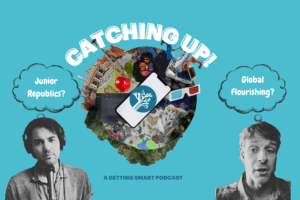International Educators Encourage Collaborative Teaching

A Native American raised in Europe working in Asia schools, Tim Stuart is a global educator. I met Tim as a Gates Millennium Scholar while he was working on a Ph.D. at Seattle Pacific University. He joined a family friend, Ron Polider, at Rehoboth Christian School in New Mexico.
From there Stuart took a leadership post at Jakarta International School, then Singapore American School (SAS), where he leads strategy. A year after Stuart moved to Singapore (in 2010), Chip Kimball joined as superintendent. Together they crafted a change agenda chronicled in a recent case study.

They used school visits to inspire a talented but isolated faculty. Exposure to the best schools in the world and a new group of critical friends resulted in updated student learning expectations.

Professional learning communities (PLC) were a critical vehicle for SAS faculty to discuss, synthesize and incorporate innovations observed on school visits and discussed in the R&D phase.
An hour at the beginning of every Wednesday is dedicated to PLCs, which means teachers of the same subject meet to discuss student learning, learning strategies, successes and struggles.
“Students learn more when teachers work in collaboration with each other in order to have learning-focused conversations that focus on student learning,” says Stuart,
Stuart’s new compilation, Global Perspectives: Professional Learning Communities at Work in International Schools, makes the case for creating high functioning collaborative teams.
Published by Solution Tree Press, Stuart collaborated with a dozen international school educators who submitted a chapter for Global Perspectives. He chose experts in their fields of international education with the book centering on the concept of PLCs.
Global Perspectives offers a new view on PLCs–one where students are engaged in the central learning questions.
|
Professional Learning Communities 1.0 Central to the Singapore American School transformation was the use of professional learning communities (PLC) as popularized by Solution Tree author Rick DuFour. SAS is a model PLC school in all divisions. Teachers collaborate in PLCs to set learning targets, refine academic offerings and develop common assessments. PLCs focus on collective learning for all students and teachers through cycles of inquiry. PLCs answer the following questions:
|
|
Professional Learning Communities 2.0 Students and teachers actively engage in effective PLCs to achieve common student-learning goals for which members are mutually accountable. Students own their own learning process by asking and answering the four critical PLC questions for themselves (see above). Every child has value and can learn at high levels. PLCs guarantee a common, viable curriculum where teachers and students take collective responsibility for student learning, and ensure that faculty and students work collaboratively to leverage their expertise and analyze evidence of learning to improve their own instructional and learning strategies and maximize their learning and growth. |
Teachers “start becoming better teachers because they’re sharing strategies and resources on how to reach those kids who aren’t learning, and how to keep those who learn quicker to get to the next level,” says Stuart. “Better teachers mean better students. Fewer kids are falling through the cracks, and more are achieving at higher levels.”
For more see
- Library 2.0: Center of Innovation at Singapore American School
- 10 Lessons in Leading New School Development
- Visiting Schools: Transformative Professional Learning
Stay in-the-know with all things EdTech and innovations in learning by signing up to receive the weekly Smart Update.







0 Comments
Leave a Comment
Your email address will not be published. All fields are required.